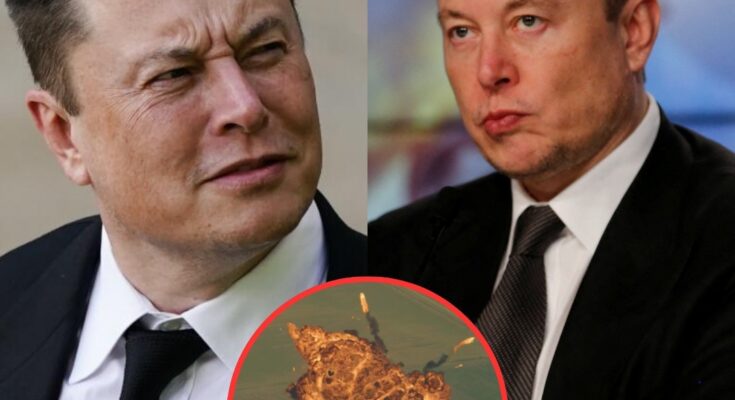In a striking and dramatic allegation within the fiercely competitive aerospace industry, Elon Musk once speculated that a sniper, positioned on the roof of a competitor’s building, might have caused the abrupt and catastrophic explosion of a SpaceX Falcon 9 rocket in 2016.
What began as a tragic and expensive mishap, resulting in the loss of a $200 million rocket and the Amos-6 Israeli communications satellite it carried, rapidly escalated into a comprehensive investigation driven by Musk’s intense paranoia, which even involved the FBI. The explosion on September 1, 2016, vividly captured on video, depicted the Falcon 9 disintegrating instantaneously during a routine static fire test.
There was no launch, no countdown, only the sudden conversion of one of the world’s most advanced rockets into a fireball. The aerospace community was left in shock, with Musk himself being the most affected.
Upon receiving the news while still at his residence in California, the billionaire CEO reportedly became fixated on the notion of potential sabotage. Information acquired through a Freedom of Information Act (FOIA) request by journalist Eric Berger revealed that SpaceX engineers initiated a serious investigation into the possibility that a sniper had targeted the rocket’s pressurized tanks, leading to their rupture and subsequent explosion.
In a decision that many might consider irrational or paranoid, Musk instructed his team to inspect the rooftop of a nearby building owned by United Launch Alliance (ULA) — SpaceX’s primary competitor — situated approximately one mile from the Cape Canaveral launch site. Engineers even went to the extent of simulating the incident by firing rounds at comparable tanks to determine if a precisely aimed shot could realistically induce such a catastrophic failure.
This suspicion was not merely a fleeting thought; it evolved into a significant aspect of the internal investigation. The involvement of the FBI later underscores the seriousness with which SpaceX and Musk regarded the incident.
The circumstances at that time only intensified Musk’s growing distrust. SpaceX found itself in an increasingly adversarial competition with ULA, a collaboration between Boeing and Lockheed Martin that had long held a dominant position in the government launch sector.
In 2014, Musk had already initiated legal action against the U.S. Air Force, alleging anti-competitive behavior and favoritism towards ULA, which effectively barred SpaceX from obtaining lucrative military contracts.
That same year, SpaceX’s Falcon 9 experienced its first significant explosion during a launch, and by 2016, the company faced tremendous pressure to demonstrate its reliability to NASA and the U.S. government.
The timing of the second explosion, occurring just as NASA began to invest significantly in SpaceX’s commercial crew program, could not have been more detrimental. Public trust began to falter.
Musk, recognized for his intense competitiveness and unwavering faith in his vision, may have perceived the explosion not merely as a technical setback, but as a calculated attempt to derail his company’s progress. The idea of a corporate sabotage sounds like a plot from a Hollywood thriller, yet within SpaceX, it was regarded with utmost seriousness.
This was not a fleeting comment made out of frustration — it was a theory that Musk actively promoted, despite the considerable doubt expressed by both law enforcement and aerospace professionals. According to documents obtained through FOIA by Berger, even the FBI was compelled to provide a formal response.
A correspondence dispatched in October 2016 clearly indicated that investigators discovered ‘no evidence to imply that sabotage or any form of criminal activity contributed’ to the explosion. Rather, the underlying cause was considerably more ordinary, albeit equally important from a technical perspective.
SpaceX engineers ultimately determined that the rocket’s pressurized tanks had been filled with super-cooled helium at an excessive rate, leading to a structural failure. This was attributed to a procedural issue — not an act of malice.
Nevertheless, Musk’s conduct in the aftermath left a profound impact. His readiness to consider and advocate for such a sensational theory, even allocating company resources to substantiate it, contributed to an emerging narrative regarding Musk’s inclination towards conspiracy theories.
At that time, it provided a rare glimpse into how the billionaire dealt with failure and challenges. As SpaceX confronted crucial government assessments and fiercely competed for supremacy in the launch industry, Musk appeared either unable or unwilling to acknowledge that the explosion was merely a consequence of engineering mistakes.
In his perspective, it had to be sabotage. It had to be a conflict. In hindsight, this event presaged the more overt expressions of distrust and confrontational rhetoric that would later define Musk’s public image, particularly in the 2020s, when he frequently launched criticisms against regulatory bodies, journalists, and former associates.
Instead of addressing the internal errors that contributed to the Falcon 9 explosion, Musk opted to assign blame and construct a narrative of betrayal. Nevertheless, despite the surrounding drama, the outcome was clear. SpaceX gained valuable insights from its setback, revised its fueling protocols, and emerged more resilient.
The company’s trajectory was not hindered; in fact, it may have been propelled forward by the heightened scrutiny and public pressure that ensued after the explosion. Musk’s peculiar theory—though ultimately disproven—served to enhance the legend surrounding him.
He transcends the roles of entrepreneur and CEO; in the eyes of both his supporters and critics, he is a figure perpetually engaged in a struggle against unseen adversaries, often of his own creation.
While the alleged sniper was a fabrication, the 2016 explosion stands as a crucial chapter in SpaceX’s narrative—a turning point that underscored the significant risks involved and Musk’s determination to safeguard his vision.


